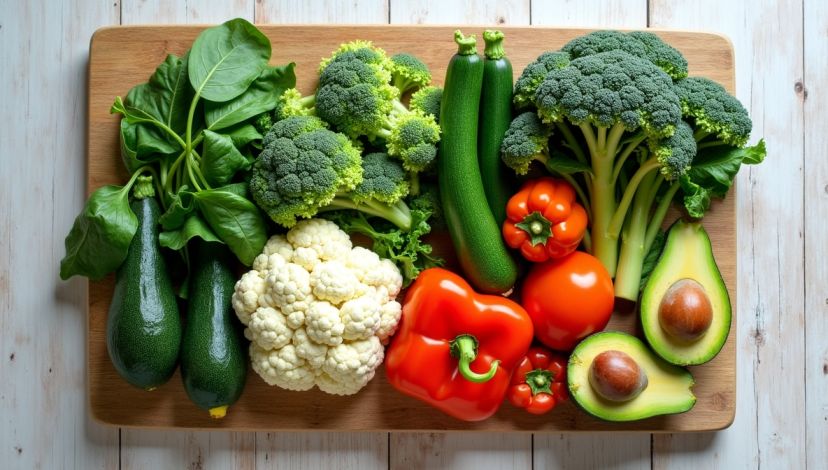Under a ketogenic diet, a person should know the type of vegetables to consume to keep the carb content at a low level and keep the body in ketosis. Although vegetables are essential sources of necessary nutrients, fibers, and antioxidants, not all of them are keto-friendly. With the list of low-net-carb green vegetables, you can freely make all sorts of dishes and adhere to the keto plan. This guide will touch on the most optimal keto-friendly vegetables, the way you can add them to your diet, and tricks to bypass more carb-heavy ingredients.
Key Points:
- Most of the vegetables considered keto-friendly also have few net carbs and high fiber.
- Vegetables above ground are typically less carbs than root vegetables.
- By adding different types of keto vegetables, the diet has well-balanced nutrition and aids in sustaining ketosis.
Which Are The Best Vegetables On Keto?
The most suitable keto-friendly vegetables are those which have less than 5 grams of net carbs content per 100-gram portion, to enjoy eating a certain amount of them pretty freely. These are spinach, zucchini, lettuce, cucumbers, cabbage, asparagus, and kale. These vegetables are also very adaptable and could be used in a salad form or to make sautés, or could be used as alternatives to high-carb foods such as pasta or rice.
As an example, cauliflower, which goes with approximately 3 grams of net carbs per 100 grams, is one of the greatest ways to create something like keto-friendly rice or mashed. Zucchini may also be used to make noodles by using a spiralizer, which is again an alternative to pasta with no carbohydrates. Spinach and kale are extremely healthy and very low in carbs, so they are a mainstay of keto meal plans.
Other vegetables like bell pepper and Brussels sprouts, and green beans have a slightly higher carbs (approximately 4-5 grams) and therefore you need to pay a little more attention to ensure that you are within carbs limits each day. Tomatoes, being considered fruit, should be added in limit, owing to the content of the carbs.
Table 1: Keto-Friendly Vegetables and their veggies content (net carbs(per 100g)
| Vegetable | Net Carbs (g) | Notes |
|---|---|---|
| Spinach | 1 | Very low carb, great raw or cooked |
| Zucchini | 3 | Versatile for noodles or fries |
| Cauliflower | 3 | Ideal for rice or mash substitutes |
| Asparagus | 2 | Perfect with high-fat sauces |
| Cabbage | 3 | Great for stir-fry or salads |
| Broccoli | 4 | Can replace rice or potatoes |
| Brussels Sprouts | 5 | Eat in moderation |
Way Of Adding Keto-Friendly Vegetables In Your Food?
Making use of keto-friendly vegetables is wholesome and imaginative. Begin with using keto vegetables instead of high-carb ones. To take an example, have rice replaced by cauliflower rice or have pasta replaced by spiralized zucchini. Extra nutrients and fiber can be added to the salads in the form of leafy vegetables such as spinach, kale, or even baby beet greens.
The ways of cooking are also important. Asparagus and Brussels sprouts make a great treat when roasted with butter or bacon fat, and carbs remain low. An easy way to eat spinach or kale is to sauté it with garlic and olive oil.
The low-carb smoothie or a keto soup will feature low-carb vegetables like cucumbers and broccoli sprouts, which can help add the texture and nutrients without a lot of carbs. Diversity is important in obtaining diverse vitamins and minerals.
Tip: Keep an eye on the amount of vegetables you eat, as you could easily go over your carbs quota.
Note: Pay attention to vegetables grown above the ground since they are more likely to be low-carb vegetables than root vegetables.
Which Vegetables should to avoided on a Keto Diet?
Although there are a lot of vegetables that complement a keto regime, some are just too high in carbohydrates to consume and should be avoided. The most common, potatoes, sweet potatoes, carrots, or beets, are root vegetables rich in starch and may easily pile up in carbs, stopping you out of ketosis.
Corn and peas are also have more net carbs, with which one should be cautious or keep away. They lead to spikes in blood sugar levels and fat-burning impairment as the ketogenic diet aims at fat-burning.
One should read nutrition labels and be careful of mixed dishes that can have hidden carbs in the form of sauce or extra sugar. In doubt, go with low-carb and non-starchy vegetables.
Table 2: Ketogenic Vegetables to avoid and the Net carbs in them (per 100g)
| Vegetable | Net Carbs (g) | Reason to Avoid |
|---|---|---|
| Potato | 17 | High starch content |
| Sweet Potato | 17 | High in carbs |
| Carrots | 7 | Moderate to high-carb |
| Corn | 19 | High sugar and starch |
| Peas | 14 | Higher carb count |
Do Vegetables Contain Any Fats, Keto-Friendly?
Most of the vegetables are low-fat, but other keto-friendly ones, such as avocados and olives, are special since they are rich in healthy fats as well, and the net carbs are low. Avocados contain approximately 2 grams of net carbohydrates in 100 grams and are a good source of monounsaturated fats, dietary fiber, and potassium, which makes them best suited for heart benefits and satiety.
Technically, olives are fruit, but they are commonly placed on keto along with vegetables since they are used as a savory food. They have antioxidants and anti-inflammatory agents like oleuropein that can guard against the assault of a cell.
When incorporated into the diet, these fat-rich keto vegetables can help you to achieve your fat intake requirements and obtain all the necessary nutrients.
How do you count carbs in vegetable foods in the Keto diet?
When dealing with the carbohydrate content of vegetables, it is necessary to know the portion size and the amount of carbohydrates it contains. Net carbs are obtained when one subtracts the fiber content of total carbs, as fiber does not elevate blood sugar.
When you want to keep track of what you consume, tools such as nutrition applications or printable keto vegetable charts may be utilized. Sticking with low-carb veggies and keeping moderate-carb veggies such as bell pepper or tomatoes to a minimum can also keep you in ketosis.
It is also helpful to plan meals, include the least net-carb vegetables as staples, and the moderate ones as side dishes. This supplies your body with the protein and good fats, which fill you with energy until the next meal.
NB: Net carbs = Total carbs fiber; Pay attention to net carbs (on the keto).
Note: The above-ground vegetables are less carb-dense as compared to root vegetables.
Conclusion
The key to a successful keto diet is to pick the appropriate vegetables. Most of the keto-friendly vegetables are low on net carbs, nutritious, and flexible to cook. Pay attention to leafy vegetables, cruciferous foods like cauliflower and broccoli, and other low-carb foods like zucchini and asparagus. Limit your starch by not consuming high-starch root vegetables and ensuring that you maintain your portions so that you do not exceed your restrained carbs.
Adding a mix of keto veggies does not only go with ketosis but also helps you maintain necessary vitamins, minerals, and fiber in your system to remain healthy. Vegetables can be the delicious and satisfying component of your keto lifestyle with a cautious selection and preparation.
FAQ’s
Q1: Is it Keto-Friendly to consume tomatoes?
The answer is yes, tomatoes are edible in moderation, because although tomatoes do have a bit more carbs, they are keto-compatible when consumed in moderate amounts.
Q2: Do all leafy vegetables go with keto?
Most leafy vegetables, such as spinach, kale, and lettuce, are so low in carbs and phenomenal on keto.
Q3: What is the number of veggie carbs that I can consume each day on keto?
Keto diets usually set a maximum of 20-50 grams of carbs daily, of which half is comprised of vegetables.
Q4: Can cauliflower be used as a rice alternative on Keto?
Definitely, cauliflower is a famous low-carb replacement for rice and mashed potatoes.
Q5: Do I need to avoid root vegetables keto diet?
The majority of root vegetables are loaded with carbs, and they need to be avoided or restricted to be able to stay in ketosis.




